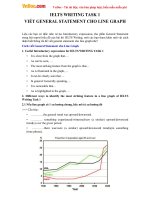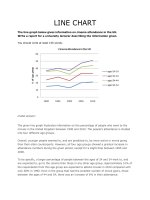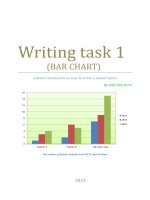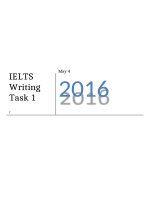Public writing task 1 band descriptors
Bạn đang xem bản rút gọn của tài liệu. Xem và tải ngay bản đầy đủ của tài liệu tại đây (56.4 KB, 2 trang )
IELTS Writing Band Descriptors: Task 1 (Public Version)
Band Task achievement Coherence and cohesion Lexical resource Grammatical range and accuracy
9
• fully satisfies all the requirements of the task
• clearly presents a fully developed response
• uses cohesion in such a way that it attracts no
attention
• skilfully manages paragraphing
• uses a wide range of vocabulary with very natural
and sophisticated control of lexical features; rare
minor errors occur only as ‘slips’
• uses a wide range of structures with full flexibility and
accuracy; rare minor errors occur only as ‘slips’
8
• covers all requirements of the task sufficiently
• presents, highlights and illustrates key features/
bullet points clearly and appropriately
• sequences information and ideas logically
• manages all aspects of cohesion well
• uses paragraphing sufficiently and appropriately
• uses a wide range of vocabulary fluently and flexibly
to convey precise meanings
• skilfully uses uncommon lexical items but there may
be occasional inaccuracies in word choice and
collocation
• produces rare errors in spelling and/or word
formation
• uses a wide range of structures
• the majority of sentences are error-free
• makes only very occasional errors or inappropriacies
7
• covers the requirements of the task
• (Academic) presents a clear overview of main
trends, differences or stages
• (General Training) presents a clear purpose, with the
tone consistent and appropriate
• clearly presents and highlights key features/bullet
points but could be more fully extended
• logically organises information and ideas; there is
clear progression throughout
• uses a range of cohesive devices appropriately
although there may be some under-/over-use
• uses a sufficient range of vocabulary to allow some
flexibility and precision
• uses less common lexical items with some
awareness of style and collocation
• may produce occasional errors in word choice,
spelling and/or word formation
• uses a variety of complex structures
• produces frequent error-free sentences
• has good control of grammar and punctuation but
may make a few errors
6
• addresses the requirements of the task
• (Academic) presents an overview with information
appropriately selected
• (General Training) presents a purpose that is
generally clear; there may be inconsistencies in tone
• presents and adequately highlights key features/
bullet points but details may be irrelevant,
inappropriate or inaccurate
• arranges information and ideas coherently and there
is a clear overall progression
• uses cohesive devices effectively, but cohesion
within and/or between sentences may be faulty or
mechanical
• may not always use referencing clearly or
appropriately
• uses an adequate range of vocabulary for the task
• attempts to use less common vocabulary but with
some inaccuracy
• makes some errors in spelling and/or word formation,
but they do not impede communication
• uses a mix of simple and complex sentence forms
• makes some errors in grammar and punctuation but
they rarely reduce communication
5
• generally addresses the task; the format may be
inappropriate in places
• (Academic) recounts detail mechanically with no
clear overview; there may be no data to support the
description
• (General Training) may present a purpose for the
letter that is unclear at times; the tone may be
variable and sometimes inappropriate
• presents, but inadequately covers, key features/
bullet points; there may be a tendency to focus on
details
• presents information with some organisation but
there may be a lack of overall progression
• makes inadequate, inaccurate or over-use of
cohesive devices
• may be repetitive because of lack of referencing and
substitution
• uses a limited range of vocabulary, but this is
minimally adequate for the task
• may make noticeable errors in spelling and/or word
formation that may cause some difficulty for the
reader
• uses only a limited range of structures
• attempts complex sentences but these tend to be
less accurate than simple sentences
• may make frequent grammatical errors and
punctuation may be faulty; errors can cause some
difficulty for the reader
4
• attempts to address the task but does not cover all
key features/bullet points; the format may be
inappropriate
• (General Training) fails to clearly explain the purpose
of the letter; the tone may be inappropriate
• may confuse key features/bullet points with detail;
parts may be unclear, irrelevant, repetitive or
inaccurate
• presents information and ideas but these are not
arranged coherently and there is no clear
progression in the response
• uses some basic cohesive devices but these may be
inaccurate or repetitive
• uses only basic vocabulary which may be used
repetitively or which may be inappropriate for the task
• has limited control of word formation and/or spelling;
errors may cause strain for the reader
• uses only a very limited range of structures with only
rare use of subordinate clauses
• some structures are accurate but errors predominate,
and punctuation is often faulty
3
• fails to address the task, which may have been
completely misunderstood
• presents limited ideas which may be largely
irrelevant/repetitive
• does not organise ideas logically
• may use a very limited range of cohesive devices,
and those used may not indicate a logical
relationship between ideas
• uses only a very limited range of words and
expressions with very limited control of word
formation and/or spelling
• errors may severely distort the message
• attempts sentence forms but errors in grammar and
punctuation predominate and distort the meaning
2
• answer is barely related to the task • has very little control of organisational features • uses an extremely limited range of vocabulary;
essentially no control of word formation and/or
spelling
• cannot use sentence forms except in memorised
phrases
1
• answer is completely unrelated to the task • fails to communicate any message • can only use a few isolated words • cannot use sentence forms at all
0
• does not attend
• does not attempt the task in any way
• writes a totally memorised response
©
UCLES 2005
IELTS Writing Band Descriptors: Task 2 (Public Version)
Band Task response Coherence and cohesion Lexical resource Grammatical range and accuracy
9
• fully addresses all parts of the task
• presents a fully developed position in answer to the
question with relevant, fully extended and well
supported ideas
• uses cohesion in such a way that it attracts no attention
• skilfully manages paragraphing
• uses a wide range of vocabulary with very natural
and sophisticated control of lexical features; rare
minor errors occur only as ‘slips’
• uses a wide range of structures with full flexibility
and accuracy; rare minor errors occur only as ‘slips’
8
• sufficiently addresses all parts of the task
• presents a well-developed response to the question
with relevant, extended and supported ideas
• sequences information and ideas logically
• manages all aspects of cohesion well
• uses paragraphing sufficiently and appropriately
• uses a wide range of vocabulary fluently and flexibly
to convey precise meanings
• skilfully uses uncommon lexical items but there may
be occasional inaccuracies in word choice and
collocation
• produces rare errors in spelling and/or word
formation
• uses a wide range of structures
• the majority of sentences are error-free
• makes only very occasional errors or inappropriacies
7
• addresses all parts of the task
• presents a clear position throughout the response
• presents, extends and supports main ideas, but
there may be a tendency to over-generalise and/or
supporting ideas may lack focus
• logically organises information and ideas; there is clear
progression throughout
• uses a range of cohesive devices appropriately
although there may be some under-/over-use
• presents a clear central topic within each paragraph
• uses a sufficient range of vocabulary to allow some
flexibility and precision
• uses less common lexical items with some
awareness of style and collocation
• may produce occasional errors in word choice,
spelling and/or word formation
• uses a variety of complex structures
• produces frequent error-free sentences
• has good control of grammar and punctuation but
may make a few errors
6
• addresses all parts of the task although some parts
may be more fully covered than others
• presents a relevant position although the
conclusions may become unclear or repetitive
• presents relevant main ideas but some may be
inadequately developed/unclear
• arranges information and ideas coherently and there is
a clear overall progression
• uses cohesive devices effectively, but cohesion within
and/or between sentences may be faulty or mechanical
• may not always use referencing clearly or appropriately
• uses paragraphing, but not always logically
• uses an adequate range of vocabulary for the task
• attempts to use less common vocabulary but with
some inaccuracy
• makes some errors in spelling and/or word
formation, but they do not impede communication
• uses a mix of simple and complex sentence forms
• makes some errors in grammar and punctuation but
they rarely reduce communication
5
• addresses the task only partially; the format may be
inappropriate in places
• expresses a position but the development is not
always clear and there may be no conclusions
drawn
• presents some main ideas but these are limited and
not sufficiently developed; there may be irrelevant
detail
• presents information with some organisation but there
may be a lack of overall progression
• makes inadequate, inaccurate or over-use of cohesive
devices
• may be repetitive because of lack of referencing and
substitution
• may not write in paragraphs, or paragraphing may be
inadequate
• uses a limited range of vocabulary, but this is
minimally adequate for the task
• may make noticeable errors in spelling and/or word
formation that may cause some difficulty for the
reader
• uses only a limited range of structures
• attempts complex sentences but these tend to be
less accurate than simple sentences
• may make frequent grammatical errors and
punctuation may be faulty; errors can cause some
difficulty for the reader
4
• responds to the task only in a minimal way or the
answer is tangential; the format may be
inappropriate
• presents a position but this is unclear
• presents some main ideas but these are difficult to
identify and may be repetitive, irrelevant or not well
supported
• presents information and ideas but these are not
arranged coherently and there is no clear progression
in the response
• uses some basic cohesive devices but these may be
inaccurate or repetitive
• may not write in paragraphs or their use may be
confusing
• uses only basic vocabulary which may be used
repetitively or which may be inappropriate for the
task
• has limited control of word formation and/or spelling;
errors may cause strain for the reader
• uses only a very limited range of structures with only
rare use of subordinate clauses
• some structures are accurate but errors
predominate, and punctuation is often faulty
3
• does not adequately address any part of the task
• does not express a clear position
• presents few ideas, which are largely undeveloped
or irrelevant
• does not organise ideas logically
• may use a very limited range of cohesive devices, and
those used may not indicate a logical relationship
between ideas
• uses only a very limited range of words and
expressions with very limited control of word
formation and/or spelling
• errors may severely distort the message
• attempts sentence forms but errors in grammar and
punctuation predominate and distort the meaning
2
• barely responds to the task
• does not express a position
• may attempt to present one or two ideas but there is
no development
• has very little control of organisational features • uses an extremely limited range of vocabulary;
essentially no control of word formation and/or
spelling
• cannot use sentence forms except in memorised
phrases
1
• answer is completely unrelated to the task • fails to communicate any message • can only use a few isolated words • cannot use sentence forms at all
0
• does not attend
• does not attempt the task in any way
• writes a totally memorised response
©
UCLES 2005









